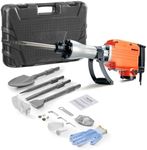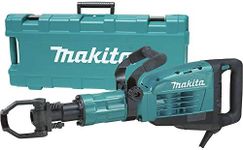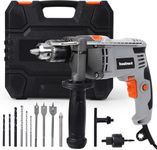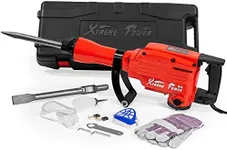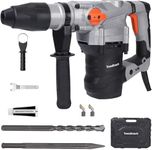Buying Guide for the Best Demolition Hammer For Tile Removal
Choosing the right demolition hammer for tile removal can make your project much easier and more efficient. A demolition hammer is a powerful tool designed to break up hard surfaces like concrete, brick, and tile. When selecting a demolition hammer, it's important to consider several key specifications to ensure you get the best fit for your needs. Understanding these specs will help you make an informed decision and choose a tool that will perform well for your specific tasks.Power (Wattage)Power, measured in watts, indicates the strength of the demolition hammer. Higher wattage means more power, which is essential for breaking through tough materials like tile. For light to medium tile removal, a hammer with 800-1200 watts should suffice. For more demanding tasks, consider a model with 1500 watts or more. Choose based on the thickness and hardness of the tiles you need to remove.
Impact Energy (Joules)Impact energy, measured in joules, determines how much force the hammer delivers with each blow. Higher impact energy means more efficient breaking of tiles. For small to medium projects, 10-15 joules is usually adequate. For larger or more stubborn tiles, look for a hammer with 20 joules or more. Match the impact energy to the difficulty of your tile removal job.
Blows Per Minute (BPM)Blows per minute (BPM) measures how many times the hammer strikes per minute. A higher BPM can make the tool more effective at breaking up tiles quickly. For general tile removal, a BPM range of 2000-3000 is typically sufficient. If you need to work faster or on tougher materials, consider a hammer with a higher BPM. Choose a BPM that aligns with your desired speed and efficiency.
WeightThe weight of the demolition hammer affects how easy it is to handle and maneuver. Lighter hammers (5-10 kg) are easier to use for extended periods and are suitable for overhead or vertical work. Heavier hammers (10-20 kg) provide more power but can be tiring to use for long durations. Consider the balance between power and comfort, especially if you have a large area to cover.
Vibration ControlVibration control features reduce the amount of vibration transmitted to your hands and arms, making the tool more comfortable to use and reducing fatigue. This is particularly important for long projects. Look for models with built-in vibration dampening systems if you plan to use the hammer for extended periods. Prioritize this feature if comfort and reduced strain are important to you.
Chisel Type and SizeThe type and size of the chisel determine how effectively the hammer can remove tiles. Flat chisels are ideal for tile removal, while pointed chisels are better for breaking up concrete. The width of the chisel should match the size of the tiles you are removing. For standard tiles, a chisel width of 1-2 inches is usually sufficient. Choose the appropriate chisel type and size based on the specific tiles you need to remove.
Durability and Build QualityDurability and build quality ensure that the demolition hammer can withstand the rigors of heavy use. Look for models made from high-quality materials with robust construction. Features like metal housings and reinforced components can extend the tool's lifespan. Prioritize durability if you plan to use the hammer frequently or for large projects.
